If you’re thinking about starting bodybuilding for the first time and would like to pack on up to 30 pounds of muscle mass, then you’ve opened this issue to the right page. This installment kicks off a series of training articles that will give you all of the latest training and nutritional information you’ll need to make it to the top of the sport’if you choose to climb that high’or simply to improve to the point of being the best built person on your street. At no time do gains come any quicker than during the first six months of training. That’s the point at which all trainees first become aware of their bodies and notice profound changes starting to happen.
Knowing Where You Stand Physically
When starting a bodybuilding program for the first time, it’s of paramount importance that you know your physical condition. In fact, an annual physical examination is recommended for all people, whether they engage in weight training or not. If your physician gives you the okay’and he or she should, unless you’re on your last legs, in which case you’d be better off tending to your estate than adding an inch to your arms’then you can begin your training.
The program you’re about to embark on will, if you follow it to the letter, improve your health, strength and muscle mass to such a degree that you and those who know you will be shocked at the metamorphosis. If you’re drastically underweight, it’s quite possible for you to gain up to 30 pounds of rock-hard muscle mass. If you’re overweight with no discernible muscle shape, be prepared to become firm, develop a V-taper, lose inches off your waist and shape and expand your chest, shoulders, legs and arms. Enough talking about it. Let’s start making it happen!
Sets, Reps, Pecs and Delts: the Jargon of Bodybuilding
Bodybuilders constitute a genuine subculture of the population, and what they do has its own idiom. Terms such as, reps, bi’s, tri’s, supersets, preexhaustion, forced reps and negatives can leave the uninitiated looking for the nearest dictionary. The language of bodybuilding is not as intimidating as it may at first appear, and it’s not even necessary for beginners to learn more than a quarter of the terms. As many relate to more advanced training techniques, we will concentrate on the baker’s dozen or so that will directly affect you in your first few months of training. Rep. A repetition, or rep, is the movement of a given muscle group against resistance from a starting position of full extension to a finishing position of full contraction and then the subsequent return to the starting position.
Set. A series of repetitions, a set can be anywhere from one rep to 100 or more. Generally, trainees take a brief rest of 30 to 90 seconds after a set to catch their breath and give the target muscle group time to partially recuperate. Generally, trainees perform one to four sets of an exercise.
Press. Any exercise in which you push the resistance away from your body with your arms or legs.
Curl. Any movement in which you pull the resistance in toward your body with your arms or legs.
Clean. No, this doesn’t have anything to do with personal hygiene. It’s a movement in which you lift a barbell or dumbbell from the floor to your chest in one quick motion.
Poundage. The amount of weight or resistance you use on an exercise.
Limit weight. The heaviest amount of resistance that you can lift for one repetition.
Routine. The total of reps, sets and exercises in any given training session.
A (Very) Brief Lesson in Anatomy and Physiology
Before you can drive a car, you have to learn what each piece of equipment involved in the vehicle’s movement does. Otherwise, your car won’t advance out of neutral. Likewise, before you can effectively train your muscles, you need to know how they function so that you can select the exercises that will best stimulate them to grow.
Without getting into a complicated dissertation on physiology, let’s examine a few of your body’s basic structures and see how they work together’and how that knowledge will lead to your becoming a more informed and, ultimately, more successful bodybuilder.
Central nervous system. The central nervous system consists of the spinal cord and brain and functions in conjunction with the peripheral nervous system, which includes the ganglia and nerves that reside outside of the brain and spinal cord. Without nerves your bones wouldn’t move because your muscles wouldn’t contract.
The parts of the nervous system are like thousands of little wires that function as transmitters, receivers and interpreters of data from all parts of the body. Movement is accomplished when the nervous system stimulates the muscles, which, in turn, move the bones via the tendinous attachments around the joints, which are connected by ligaments. Damage to the CNS, obviously, would impair your movement potential.
Ligaments. Ligaments are fibrous bands that bind bone to bone, and their compactness determines to a very large extent the flexibility of your joints. Conversely, you must exercise great caution when training because if you stretch a ligament too far, the joint that it holds together will become loose, resulting in permanent damage. That explains why some football players are never able to recover fully from serious knee injuries. A joint that has been injured in that way will often go out without warning, due to the instability of its overstretched ligaments.
Tendons. These are the dense, fibrous bands at the end of muscles that attach muscles to bones. In the tendons themselves are the golgi tendon apparatuses, which send signals to the brain to indicate stress and fatigue. Generally, the ache that you experience during strenuous exercise is being transmitted via the tendon, not the muscle.
Bones. You undoubtedly know what bones are. The human skeleton includes 206 bones. Muscles are attached to bones by tendons and assist us in moving from one position to another.
Muscles. The human body has three distinct kinds of muscle tissue: cardiac, skeletal and smooth. The heart is made up of cardiac muscle, while smooth muscle is found inside organs such as the stomach and intestines and assists in the passage and digestion of food. Skeletal muscle, on the other hand, is responsible for moving the bones. As there are more than 600 skeletal muscles, the ratio of skeletal muscle-to-bones in the body is 3-to-1, which accounts for our highly evolved dexterity and precision in movement.
In short, nerves stimulate the muscles, which in turn move the bones via the tendinous attachments. When functioning properly, the human body is an intricate piece of machinery. Your objective as a bodybuilder is to increase the efficiency of your machine through regulated periods of stress applied as tension on the muscles, tendons and ligaments so the central nervous system will transmit the signal for overcompensation, or muscle growth, to take place.
Anatomy and Exercise When selecting exercises to perform for specific muscle groups, it’s a definite asset to know the functions of the muscles you’ll be targeting. The Muscle Groups and Exercise Chart on page 236 will help. While the list is admittedly incomplete, it’s perfect for beginners to use for building muscle mass in the major bodyparts’a base from which you can specialize on minor bodyparts when you reach a more advanced, muscular state.
Training Principles Obviously people who take up bodybuilding want to increase their muscle size. Unfortunately, enthusiasm can be a bodybuilder’s worst enemy. Aspiring trainees often work out every day, perform as many sets as they can tolerate and then wonder why their progress is so slow. It doesn’t have to be that way’provided that you train properly. In fact, if you train exactly as I describe, you’ll be amazed at the transformation that will take place in just a few weeks. Weight training is powerful medicine that forces your body into an instant response.
The harder you train, the faster your body overcompensates in the form of additional muscle mass and the more recuperation it requires in order to bring about the physiological renovations to your physique.
Your initial program will be a three-days-per-week training schedule, which, incidentally, happens to be the most result-producing method of bodybuilding in existence. The legendary Steve Reeves used it exclusively in building his incredible physique. Mike Mentzer, perhaps the greatest and most massively developed bodybuilder of all time, used a three-days-a-week routine right up until the day he won the ’76 Mr. America title. In short, the three-days-per-week system works and has put more muscle on more people than any other training system in the world. Here are a few simple rules to follow that will ensure your success:
1) Don’t train more than three days a week.
2) Concentrate on each exercise; try to develop a mind/muscle link, to the point where you’re keenly aware of the muscles contracting against the resistance. Don’t ever start a set with the idea that you can simply get the weight to the top using any means possible.
3) Don’t cheat your exercises. In other words, don’t use body swing or momentum to complete a contraction, no matter how difficult the exercise becomes. Cheating increases momentum, which, in turn, diminishes muscular involvement and reduces the exercise’s productivity. Your goal is to involve as many muscle fibers as possible.
4) Try not to engage in anything too strenuous on your off days (you’ll be training on Monday, Wednesday and Friday), as that will cut into your recovery ability. Engaging in other activities will only limit your progress.
5) Perform each movement slowly and under control to ensure that the target muscle group is doing all the work, with no momentum. Remember this rule of thumb regarding velocity: Lift the weight in two seconds, hold it at the top for another two seconds, and then lower it back to the starting position in four seconds.
If you’re new to weight training, it’s important to know that it will be a major shock to your physiological system; it’s the most intense form of exercise in existence’which is precisely why it produces such dramatic results. Too much of a good thing at this stage of your development is not at all desirable, however, so you should do only one set of each exercise during the first month of training. Here’s the routine:
The Basic Routine
Squats* 2 x 15
Pullovers* 2 x 12
Bench presses 2 x 15
Standing barbell presses 2 x 10
Barbell rows 2 x 10
Standing barbell curls 2 x 10
Deadlifts 2 x 15
Crunches 2 x 20
Note: 2 x 15 means two sets of 15 reps each.
*Perform squats and pullovers back to back: As soon as you finish your first set of squats, immediately do your first set of pullovers. Rest and then repeat the cycle.
Remember to train on Mondays, Wednesdays and Fridays. Under no circumstances should you attempt to get all three workouts in by training three days in a row. Physiologists have determined that, unless you’re a natural in the purest sense of the word, your body needs a minimum of 48 hours of rest between workouts to recover from the training session and for your muscular subsystems to overcompensate in the form of increased muscle mass. Essentially, a Monday-Wednesday-Friday program has you on the following schedule: Train hard, then rest to recover and grow; train hard, then rest to recover and grow; train hard, then rest for two days to recover and grow.
The details of how you should perform each exercise are crucial. Read carefully every word of the exercise description before attempting it, as your success depends on proper execution of the exercises. I suggest moderate weights to start in order to ensure that you use correct form. Never complete a movement too rapidly. Perform every exercise as the muscular effort it should be.
Exercise Descriptions
Squats. Without question, squats are the single most result-producing bodybuilding exercise. If you want to pack on pounds of solid muscle weight all over your physique, give your all to squatting properly. And certainly it’s the most effective leg builder you can do with weights. To perform the squat properly, stand erect with a barbell across your shoulders and take a deep breath. With your lungs full, bend your knees and lower your body until you’re in a full squat position: The angle formed by your upper and lower leg should be slightly less than 90 degrees. As soon as you reach the bottom position, rise immediately’under control’while at the same time expelling the air from your lungs so you’ll be ready for another breath at the completion of the rep. Breathe in, and down you go for your second repetition, and so on until you perform the required number of repetitions. Keep your head up at all times, and hold your chest high. Some bodybuilders accomplish that by fixing their eyes on a spot ahead of them and approximately two to three feet above eye level until the movement is finished. Others prefer to squat with a small board under their heels to improve their balance. If you feel your balance is off (which it may be owing to innate variations in bone structure), by all means use a board or a 10-pound plate under each heel. Squats strongly affect the quadriceps, the four-headed muscle that makes up the bulk of the front thigh. The quadriceps straightens the leg and flexes the hip.
As soon as you complete your first set of squats, immediately pick up a barbell and perform your second exercise, pullovers. That technique of immediately transfering from one exercise to another is known as a superset, and you take a 60-to-90-second breather between supersets. Note that you only perform supersets on the first two exercises.
Pullovers. There’s a twofold approach to developing a massive chest: develop your pectorals with weight work and perform stretching exercises that expand the rib cage, such as pullovers. Doing them both will enlarge the external musculature of your chest as well as its internal structure.
The straight-arm pullover is quite simple to perform. Recline on a bench with a light barbell (or hold one dumbbell vertically with your palms against the inside of the top plate) at arm’s length over your chest. Slowly lower behind you until the weight is even with the bench behind you. Make a concerted effort to keep only a slight bend in your elbows throughout the movement and to draw in as much oxygen as you can while lifting your chest as high as possible when you inhale. The weight on the bar is not a major factor in this exercise; however, the degree of stretch most certainly is. A weight range of between 10 and 20 pounds should be fine’depending on your starting strength.
Bench presses. Because of the number of muscle groups it brings into play’triceps, pectorals, deltoids and lats, to name a few’the bench press is an efficient upper-body exercise. As the pectorals’ main kinesiological function is to draw the arms into the midline of the body, or to adduct the arms, the action of the arms during a bench press closely parallels the pectorals’ primary function. The bench press has its shortcomings, but for beginners in search of overall muscle mass increases, it’s the perfect exercise.
The bench press has great poundage potential, and that, combined with the fact that it stimulates so many muscles at one time’admittedly some more than others’makes it like the squat in that it’s a tremendous weight-gaining exercise.
To perform the exercise properly, lie on a bench with a barbell at arm’s length over your chest. Slowly lower the bar to your middle chest. Once it touches your chest’don’t bounce the weight, or you could get injured’slowly press the bar back to the starting position and repeat for the required number of repetitions. Put the weight on the rack, rest briefly, and then perform a second set.
Standing barbell presses. To the uninitiated, this is the touchstone of physical strength. In fact, even experienced trainees evaluate strength based on performance of this exercise. The standing barbell press is an excellent deltoid developer and also stimulates growth in the trapezius and, in the top, lockout position, the triceps muscles. To perform it properly, clean the barbell to your upper chest or the front of your shoulders, then slowly press the weight upward until your arms are fully extended over your head. Slowly lower the resistance back down to your shoulders and repeat the procedure for the required number of repetitions. Rest briefly, and then perform your second set.
Try not to cheat on this exercise’no assistance from the legs or excessive back arching. Sure, you can hoist up a few more pounds by using little dodges, but that’s not your objective. You want your shoulders to receive the bulk of the stress and, consequently, the bulk of the muscle stimulation. Note that when I say to return the bar to the starting position, I don’t mean to take it all the way to the floor. The bar should only be cleaned once during each set’before the first rep.
Barbell rows. It’s always impressive to see well-developed upper-back muscles that fan out from the waist to the shoulders to give the body that much-sought-after V-shape. One of the best upper-back exercises for developing that V-shape is the bent-over barbell row. In fact, the bulk of the stress from barbell rows hits the latissimus dorsi, a large, flat muscle whose name, translated from the Latin, means ‘broadest of the back.’ Even though the lats, as they’re called, are situated on the back, they are, in effect, arm muscles, as their action is to draw the arm back behind the midline of the body and downward, as in, for example, rowing a boat or climbing a rope.
To perform barbell rows, bend at the waist so your torso is at a right angle to your legs. Pick up a barbell, holding it at arm’s length, with your palms facing you (you can also do these with an undergrip). Your hand spacing on the bar should be between two and 2 1/2 feet. Slowly pull the bar up toward your torso until it touches your lower chest. From that fully contracted position, slowly lower the resistance back to the starting position, fully extending your arms, and repeat for the required number of repetitions. Rest briefly and then perform a second set. Make sure the barbell only touches the floor when the set is completed; holding it above the ground ensures maximum stimulation on the lats throughout the set. Also, remember to maintain the proper bent-over position throughout the set.
Standing barbell curls. The muscles involved are the biceps and brachialis of the upper arm. The biceps, located on the front of the upper arm, lies on top of the brachialis and is responsible for pronating your wrist to a palms-up position and, in conjunction with the brachialis, flexing the elbow joint. These are the muscles that bend the arm, such as when you bring food to your mouth or hold a telephone receiver to your ear.
The performance of the barbell curl is quite rudimentary: Stand erect taking a shoulder-width grip on a barbell with your palms facing away from you. Your arms should be fully extended so that the barbell is directly in front of your thighs. Slowly lift, or curl, the barbell up to shoulder height by bending your elbow, using only the muscles of your upper arm. From the fully contracted position, when the bar is near your shoulders, slowly lower the resistance back to the starting, fully extended, position. Repeat for the required number of repetitions and then rest briefly before performing your second set. Remember to let your upper arms do all the work. Fight the tendency to swing your body, shrug your shoulders or add momentum to the movement.
Deadlifts. This is a tremendous overall muscle developer and is the single most productive exercise for working the muscles of the lower back, the erector muscles, which keep the spine erect. To perform them properly, stand erect with your feet just under the barbell. Bend your knees and grasp the barbell with your hands a little wider than shoulder width apart and your knuckles facing ahead of you. Slowly begin to stand erect, straightening your legs as you go. Keep lifting the resistance until you’re completely erect and the bar is in front of your thighs. Slowly lower the resistance until it’s back on the floor again and repeat for the required number of repetitions. Rest briefly and then do another set.
Be sure to draw your shoulders well back at the completion of each repetition in order to involve the trapezius muscles, which slope down from your neck to your upper shoulders.
Crunches. This exercise strongly activates your abdominal muscles, which, when fully developed, really set off a well-muscled physique. How your abs appear’if they appear at all’will be largely due to your diet, a subject I’ll cover in a future installment of this series. Understand that no stomach exercise’repeat, no stomach exercise’will melt, burn or otherwise metamorphosize bodyfat. Don’t make the mistake of thinking that if you perform situp after situp you’ll be ridding your abdomen of surplus adipose tissue, a.k.a. fat. That’s just not the way human physiology functions. Train hard to develop your stomach muscles and then diet to reduce your subcutaneous bodyfat stores, and your abs will stand out in bold relief.
To perform crunches effectively, lie faceup on the floor with your hands behind your head, your lower legs up on a bench and your feet together. Try to keep your chin on your chest throughout the movement. From that starting position slowly curl your trunk upward toward a sitting position. You’ll find that you can get a third of the way up, which is fine because that’s all the range of motion that your abdominals need for optimal stimulation. Once you’ve ascended to a fully contracted position, hold for a two count and then lower yourself slowly back to the starting position. Repeat for the required number of repetitions and then rest briefly before performing your second set, the final set of the workout.
Concentrate and train hard during your first month on this program. You should notice a drastic difference at the end of the month. You’ll be looking and feeling the better for it. Next month I’ll guide you through the second stage of your beginning bodybuilding program.
Editor’s note: John Little is a leading innovator of bodybuilding training. Watch for his latest book, Fast Mass: The Max Contraction System. IM













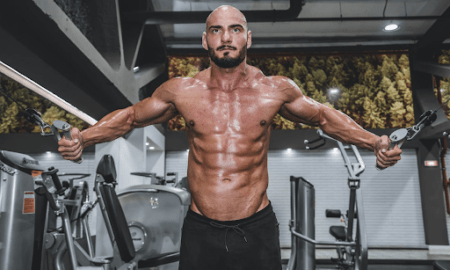

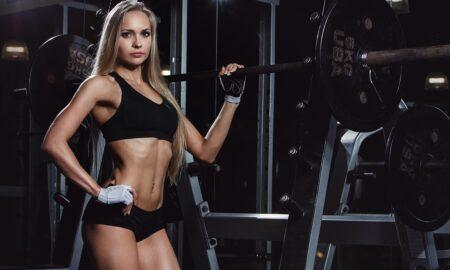
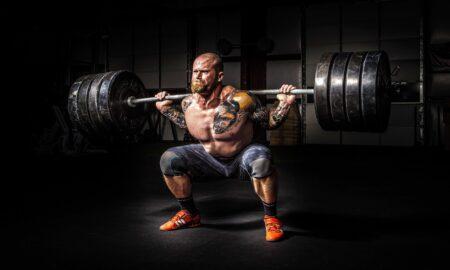
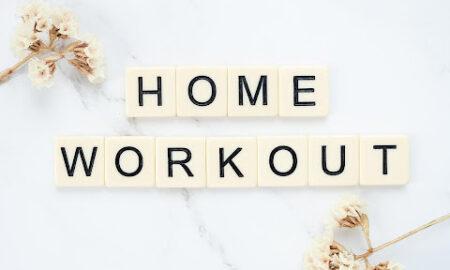

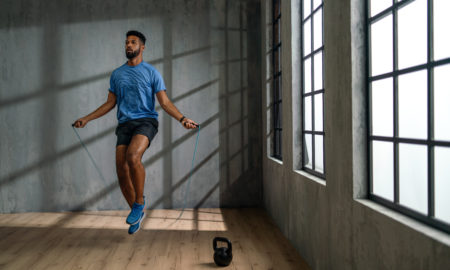
You must be logged in to post a comment Login